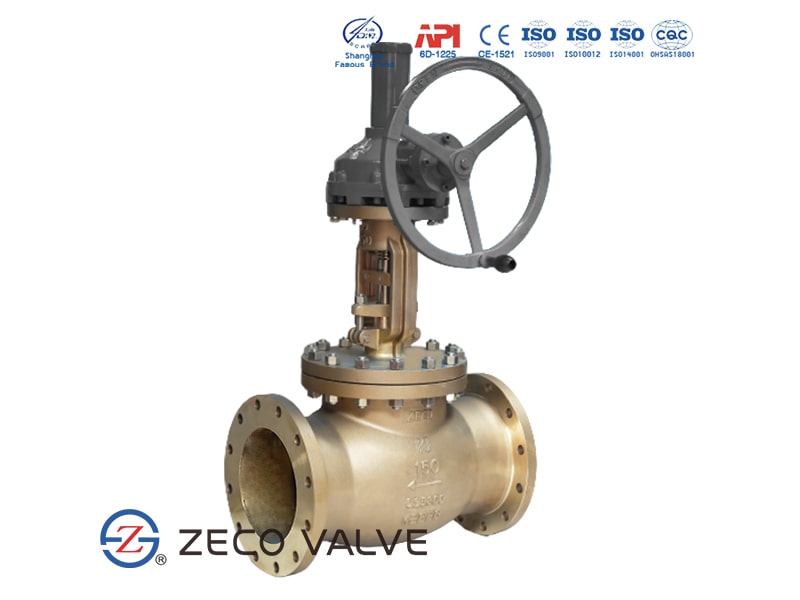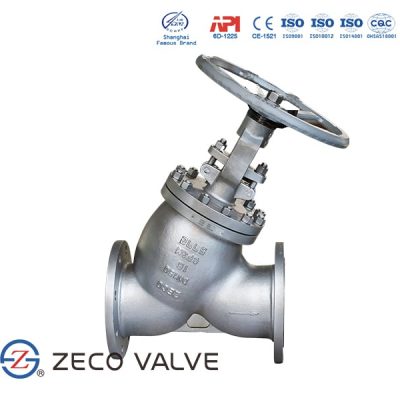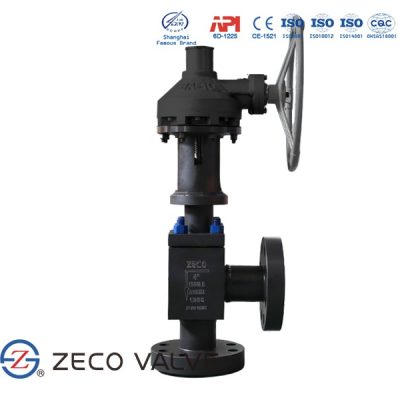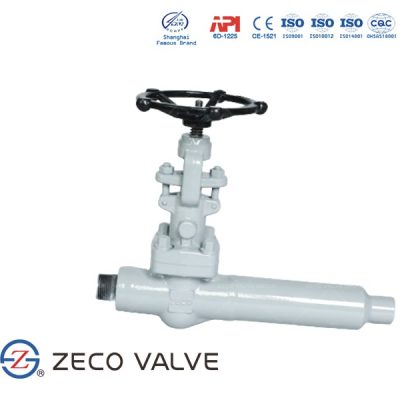Description
Flanged globe valves provide superior performance and reliability in a wide range of applications.
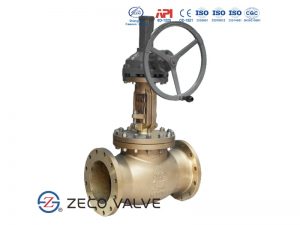
What is a Flange Globe Valve?
ZECO flange globe valve can be divided according to the location of the stem thread. Flange globe valve stem thread is outside of the body, the advantage is that stem erosion from the medium, easy lubrication such structure is common. Manual globe valve stem thread is in the body. This structure makes the stem thread in contact with the medium directly, is east to erosion, and no lubrication. It is generally used for small sizes and low temperatures. And ZECO provides these two types of construction: rising stem and rising-rotating stem. ZECO flange globe valve is a torque seated valve that is used for on-off service as well as for throttling purposes and is widely selected for their short travel. ZECO manufactures the full series of globe valves, including T type, Y type, and angle type.
Product Overview of Flange Globe Valves
- Outside Screw and Yoke (OS&Y) – Rising Stem Design
- Size Range: NPS 1/2″-16″ (DN 15-600)
- Pressure Class: ASME Class 150; ASME Class 300; ASME Class 600 [See Data Sheet for availability by size & material]
- Body Materials: Cast Steel, Cast Stainless Steel
- Standard: ASME B16.34
- End Connections: Flanged, Butt Weld
Globe Valve Parts
Now that you know what a globe valve is, let’s dive into a detailed explanation about different globe valve parts and learn their function in a globe valve, one by one.
No matter what type of globe valve you have, there are several key parts that all globe valves contain: body, seat ring, cage, bonnet, stem, plug (disk), yoke, yoke nut, back seat, packing, and valve Actuator.
- Body
- The body is the main structure of the valve that keeps everything together. This part contains all internal parts of the globe valve to allow the control of the substance that needs regulation. The opening of the body contains ports (usually two or three ports) to enable the movement of the fluid to the inside or outside of the globe valve.
- Seat Ring
- The seat is among other globe valve parts that seal the space between the disk/stem and bonnet. The seat ring can be screwed into the valve or torqued. The seat is also known as a seat ring and provides a shutoff surface that’s stable and also replaceable. Seat rings can hold the cage firmly to the body of the valve.
- Cage
- The cage is also a globe valve part which we already mentioned its name while we explained the function of the seat ring! This cage has been designed to surround the stem and the plug within the globe valve. The cage is among the parts that determine the flow within the globe valve. With the movement of the plug, the flow can increase or decrease. Based on the layout and the design of the openings, the flow of the material inside the valve differs.
- Another task that cages are responsible for is to help guide the plug to the seat to provide a good shutoff.
- Bonnet
- The bonnet is one of the outer globe valve parts that’s connected to the body to provide a leak-proof closure. There are different bonnet types such as bolted, screw-in, or union bonnets that are used in different globe valves. Each of these bonnet types has its own advantages. For example, the union bonnet not only adds strength to the body but is also great for applications that need regular cleaning or inspection. The screw-in bonnet with its simple design offers a pressure-tight seal. And the last bonnet type, the bolted bonnets that are attached with bolts are great for higher pressures.
- Stem
- The stem is part of the globe valve that connects the disk to the handwheel or the valve actuator to transmit the actuation force. Since it connects the actuator to the parts inside of the globe valve, it is considered as one of the critical globe valve parts. If the valves are controlled by actuators, the stem is smooth but for the manual valves, they are threaded.
- The ends of smooth steam are threaded allowing the connection to the actuator and the plug. A wearable packing surrounds the smooth stem to prevent leaking material from the valve. So, the packing should be replaced regularly in the maintenance period. The stem can withstand a large amount of compression force in the closure state. And when the valve is opening, it has high tensile strength.
- Plug (Disk)
- The plug or the disk is among the essential globe valve parts. It moves perpendicular to the seat and its movement can block or free the flow since it works as a moveable physical barrier. When the valve is closed, the plug sits against the seat to block the flow, and when it sits above the seats. it enables the flow of the material.
- Different disk arrangements have been designed for globe valves such as composite type, ball type, and needle type. The composite disk can provide a better shut-off, while the ball type is used for low-temperature and low-pressure systems. The needle disk has the advantage of providing better throttling compared to the other two.
- Trim
- The operating parts of a valve that are normally exposed to the process fluid are referred to as ‘valve trim’. Valve trim is the physical shape of the plug and seat arrangement. The shape of the valve plug determines the flow characteristics of the valve.
- The primary trim components for globe valves include the stem, disc and seat, seating surfaces, and the backseat if an operable backseat is installed in the valve. The area where confusion exists in globe valves concerns the ancillary components such as nuts and washers that help to contain and align the disc. Some manufacturers consider these items trim, while others do not. Alignment cages or seat-guided disc connections are sometimes added to the trim designation list as well.
- Different valve characterizations may be achieved by re-shaping the valve trim. For instance, the plug profiles of a stem-guided globe valve may be modified to achieve the common quick-opening, linear, and equal-percentage characteristics.
- Yoke
- A Yoke connects the valve body or bonnet with the actuating mechanism. The top of the Yoke holds a Yoke nut, stem nut, or Yoke bushing, and the valve stem passes through it. A Yoke usually has openings to allow access to the stuffing box, actuator links, etc. Structurally, a Yoke must be strong enough to withstand forces, moments, and torque developed by the actuator.
- Yoke Nut
- A Yoke nut is an internally threaded nut and is placed on the top of a Yoke by which the stem passes. In Globe valves, the nut is fixed and the stem is rotated through it.
- Back Seat
- A back seat is a seating arrangement inside the bonnet. It provides a seal between the stem and bonnet and prevents system pressure from building against the valve packing when the valve is fully open. Back seats are often applied in gate and globe valves.
- Packing
- Valve packing is a gasket that provides a sturdy seal between the valve’s stem and the bonnet. It is used to prevent liquid leaks in valve stems and stuffing boxes. In most valves, gland followers are tightened until the valve is leak-proof. Loose packing results in leakage; tight packing negatively affects the valve movement and may cause damage to the stem.
- Packing is available in different materials, like PTFE, elastomers, fibrous material, etc. The valve packaging shall be properly designed and manufactured to minimize the possible damages to the stem and minimize the risk of leakages of fluids. On the other hand, it is necessary to observe that a too-tight packing may affect the stem.
- Valve Actuator
- The valve actuator operates the stem and disk to open and close the valve. There are several types of actuators depending on the needs of the system such as the torque necessary to operate the valve, speed, and the need for automatic actuation.
Features of Flange Globe Valves
- ZECO designed the valve stem of flange globe valve as anti blow out structure. When the globe valve needs to be maintained, when there is pressure in the pipeline, ZECO’s design can prevent the maintenance personnel from unnecessary accidents caused by the valve stem flying out when the packing gland is removed;
- The disc of ZECO flange globe valve can be selected according to the requirements of the user’s working conditions, one is the general switch type disc, the other is the adjustable type disc, the adjustable type disc has better regulating performance in the pipeline which needs to be adjusted;
- Male and female bonnet joints for Class 150 to 600 globe valves, and ring joint for the Class 900 & above globe valves or as an option for Class 600 valves on customer request;
- ZECO has a full stock of flange globe valves for bulk delivery by oil companies and industrial company customers.
Material of Flange Globe Valves
| No | Part | Material |
| 1 | Body | ASTM A217 WC6 |
| 2 | Disc | ASTM A182 F11 + STL |
| 3 | Stem | ASTM A276 410 |
| 4 | Bonnet Gasket | Graphite + SS316 |
| 5 | Bonnet | ASTM A217 WC6 |
| 6 | Bonnet Bolt | ASTM A193 B16 |
| 7 | Bonnet Nut | ASTM A194 4 |
| 8 | Stem Packing | Reinforced Graphite |
| 9 | Gland | ASTM A276 410 |
| 10 | Gland Eyebolt | ASTM A193 B16 |
| 11 | Stem Nut | ASTM B148 |

